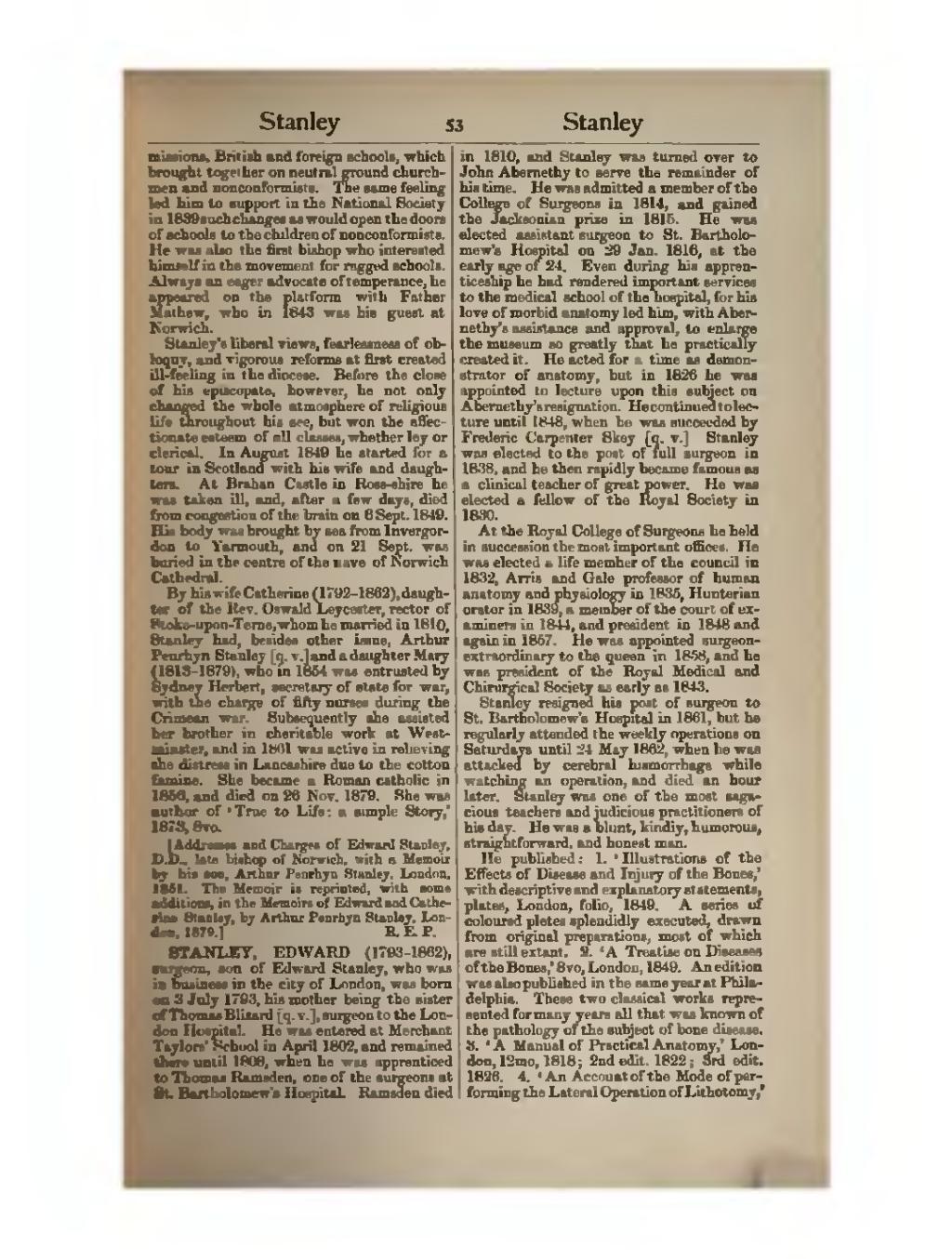missions, British and foreign schools, which brought together on neutral ground churchmen and nonconformists. The same feeling led him to support in the National Society in 1839 such changes as would open the doors of schools to the children of nonconformists. He was also the first bishop who interested himself in the movement for ragged schools. Always an eager advocate of temperance, he appeared on the platform with Father Mathew, who in 1843 was his guest at Norwich.
Stanley's liberal views, fearlessness of obloquy, and vigorous reforms at first created ill-feeling in the diocese. Before the close of his episcopate, however, he not only changed the whole atmosphere of religious life throughout his see, but won the affectionate esteem of all classes, whether lay or clerical. In August 1849 he started for a tour in Scotland with his wife and daughters. At Brahan Castle in Ross-shire he was taken ill, and, after a few days, died from congestion of the brain on 6 Sept. 1849. His body was brought by sea from Invergordon to Yarmouth, and on 21 Sept. was buried in the nave of Norwich Cathedral.
By his wife Catherine (1792–1862), daughter of the Rev. Oswald Leycester, rector of Stoke-upon-Terne, whom he married in 1810, Stanley had, besides other issue, Arthur Penrhyn Stanley [q. v.] and a daughter Mary (1813–1879), who in 1854 was entrusted by Sydney Herbert, secretary of state for war, with the charge of fifty nurses during the Crimean war. Subsequently she assisted her brother in charitable work at Westminster, and in 1861 was active in relieving the distress in Lancashire during the cotton famine. She became a Roman catholic in 1856, and died on 26 Nov. 1879. She wrote ‘True to Life: a simple Story,’ 1873, 8vo.
[Addresses and Charges of Edward Stanley, D.D., late bishop of Norwich, with a Memoir by his son, Arthur Penrhyn Stanley, London, 1851. The Memoir is reprinted, with some additions, in the Memoirs of Edward and Catherine Stanley, by Arthur Penrhyn Stanley, London, 1879.]
STANLEY, EDWARD (1793–1862), surgeon, son of Edward Stanley, who was in business in the city of London, was born on 3 July 1793, his mother being the sister of Thomas Blizard [q. v.], surgeon to the London Hospital. He was entered at Merchant Taylors' School in April 1802, and remained there until 1808, when he was apprenticed to Thomas Ramsden, one of the surgeons at St. Bartholomew's Hospital. Ramsden died in 1810, and Stanley was turned over to John Abernethy to serve the remainder of his time. He was admitted a member of the College of Surgeons in 1814, and gained the Jacksonian prize in 1815. He was elected assistant surgeon to St. Bartholomew's Hospital on 29 Jan. 1816, at the early age of 24. Even during his apprenticeship he had rendered important services to the medical school of the hospital, for his love of morbid anatomy led him, with Abernethy's assistance and approval, to enlarge the museum so greatly that he practically created it. He acted for a time as demonstrator of anatomy, but in 1826 he was appointed to lecture upon this subject on Abernethy's resignation. He continued to lecture until 1848, when he was succeeded by Frederic Carpenter Skey [q. v.] Stanley was elected to the post of full surgeon in 1838, and he then rapidly became famous as a clinical teacher of great power. He was elected a fellow of the Royal Society in 1830.
At the Royal College of Surgeons he held in succession the most important offices. He was elected a life member of the council in 1832, Arris and Gale professor of human anatomy and physiology in 1835, Hunterian orator in 1839, a member of the court of examiners in 1844, and president in 1848 and again in 1857. He was appointed surgeon-extraordinary to the queen in 1858, and he was president of the Royal Medical and Chirurgical Society as early as 1843.
Stanley resigned his post of surgeon to St. Bartholomew's Hospital in 1861, but he regularly attended the weekly operations on Saturdays until 24 May 1862, when he was attacked by cerebral hæmorrhage while watching an operation, and died an hour later. Stanley was one of the most sagacious teachers and judicious practitioners of his day. He was a blunt, kindly, humorous, straightforward, and honest man.
He published:
- ‘Illustrations of the Effects of Disease and Injury of the Bones,’ with descriptive and explanatory statements, plates, London, folio, 1849. A series of coloured plates splendidly executed, drawn from original preparations, most of which are still extant.
- ‘A Treatise on Diseases of the Bones,’ 8vo, London, 1849. An edition was also published in the same year at Philadelphia. These two classical works represented for many years all that was known of the pathology of the subject of bone disease.
- ‘A Manual of Practical Anatomy,’ London, 12mo, 1818; 2nd edit. 1822; 3rd edit. 1826.
- ‘An Account of the Mode of performing the Lateral Operation of Lithotomy,’

